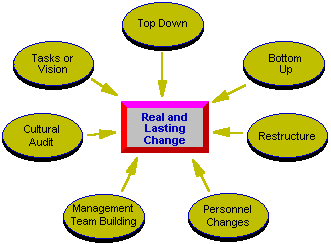Cultural Change
This page examines team building for organisations, or 'cultural change'. It discusses one of the biggest issues for cultural change programmes - how to ensure the change is real and lasting - and outlines some of the alternative approaches that can be used.
Cultural Change can be successful only when you have a good understanding of the difference between the culture you currently have, and the culture you are trying to build. Clear and objective measurement is one common feature of successful cultural change programmes.

One way that you can achieve this measurement, and therefore understanding of the culture, is to pursue the first two steps in the life cycle of a 'top-down' cultural change programme, shown in the diagram. It starts with defining in precise terms the culture you are trying to build, which can be used to determine the change you need to make. Without this information, the planning stage cannot be properly focused, and is therefore a bit of a 'stab in the dark'.
The audit can be repeated at various stages, most notably at the end, in order to assess the impact of the programme. In fact, as in many walks of life, measurement is an important key to reducing the risk of failure. It can provide an early warning system for when things are not going as planned, enabling management to take appropriate corrective action.
The importance of follow up
The most important feature of successful cultural change programmes is the follow-up - but one that is most often left to drift. Without good follow up, all the effort put into the earlier stages can be lost, and the organisation may revert to its original state, or worse. It will also build cynicism that makes it difficult for management to implement future programmes.Other key factors
People need to be both empowered and motivated in order for real change to take place. That is, you need to achieve a situation where all of management and staff are both able and willing to change.- A cultural audit will in itself facilitate change - 'if you measure it, you change it'. A very powerful form of measurement is to obtain customer feedback on the service provided - this provides a significant motivation for change across all levels of management and staff.
- The behaviours and attitudes in the department often reflect those exhibited in the management team - undertake some management team building and it will have a knock-on effect throughout the whole organisation.
- Changing people in influential positions can have an effect on the culture - but their personalities and approach need to be 'different' to the existing culture. They also need to be encouraged in bringing a fresh approach, or else it might be their behaviour that changes (by conforming) rather than the culture.
- A well-designed organisational change can also change the culture. But beware - as Caesar first observed, reorganisation can simply be a substitute for achievement.
- A 'bottom up' programme is more pragmatic - trying to change the culture in a few parts of the organisation and hoping it will spread out from there. These are generally cheap programmes, but not that effective.
- A well-designed mission, vision, or set of objectives will also facilitate change. Having 'a mission' is not good enough - it has to be a 'motivating mission' that inspires people and makes them feel good about coming to work.
Cultural Change part 2: cost and investment
©2013 Team Technology. Privacy policy and cookies.

